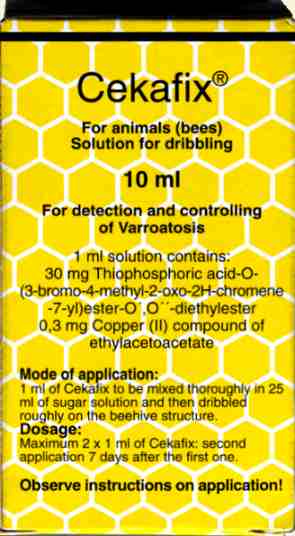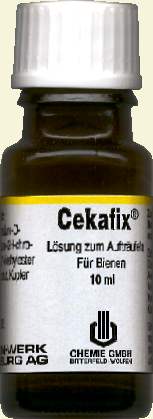Chemical Treatments
|
|
|
|---|
|
Chemical Treatments |
|
|---|
General note on chemicals: I do not endorse or advise on chemical treatments, as I am not qualified to do so and there may be dangers beyond my control. New products may be introduced or existing ones withdrawn, so it is difficult to keep up with current information on a website such as this. As many of the chemical pages were generated by Dave Cushman, I am leaving the content mainly as left by Dave for historical purposes only, which may mean information is out of date and unreliable. The user should seek guidance from other sources and satisfy themselves regarding safety and legality. Roger Patterson.
|

|
|---|
|
I neither endorse nor condemn this product. The information is taken from a leaflet produced by the manufacturers, but has been edited for reading by English speakers - as the translation provided in the original leaflet was a little crude. The sense of the information has not been changed by this editing. The details are published here is a matter of public record. The information is placed here for the education of those that wish to read it. It is important that... BEFORE you obtain or use the chemical concerned, please ascertain the legality of doing so in your location as the product may or may not be approved in your geographic State or Country. There is always the possibility that approval may have originally been granted and that subsequently such approval has been withdrawn. The pack contains a 10 ml bottle and an eyedropper that has calibrated markings at 0.5 ml and 0.75 ml. There is also an instruction leaflet. A 10 ml bottle is sufficient to treat five bee colonies. |

|
|---|

| INSTRUCTIONS for APPLICATION
Cekafix®
Composition:
Area of application:
Warning:
Safety precautions: |
|---|
Side effects:
Side effects are not known with respect to the application of Cekafix, but should you
observe any side-effects during the application of Cekafix, please inform your veterinary
practice or chemist.
Interaction with other preparations: -
There IS a contraindication to AMITRAZ. Not to be applied with any other Varroacides.
![]() Dosage instructions:
Dosage instructions:
Unless otherwise prescribed, CEKAFIX is to be applied a maximum of 2 times according to
the degree of infestation. Dosage per treatment is 1 ml of CEKAFIX for one normally
developed colony. For weak or young colonies, swarms or nuclei 0.5 ml of CEKAFIX is
sufficient for one treatment. The concentrated Cekafix is measured out using the calibrated
eye dropper provided.
Mode of application:
CEKAFIX shall be used as a ready-to-use emulsion that is prepared immediately before
application 1 ml of CEKAFIX shall be mixed with 25 ml of a 50% sugar solution.
This mixing should be done very quickly and thoroughly in order to create a milky emulsion.
Providing that the winter cluster has not yet been formed, the medication shall be dribbled
roughly on the wooden structure of the beehive. This is to avoid any contamination of the comb area.
If the winter cluster has formed, the solution should be dribbled directly on to the clustering bees. According to the type of beehive, various means- e.g. a dropper bottle or a large medical syringe with a long cannula or nozzle attached. Spraying of the medicating solution should be avoided, In exceptional (urgent) cases, water may be used for preparation of the ready-to-use emulsion.
Duration of application:
For detection of Varroa, one single treatment, by applying 1 ml of CEKAFIX, is
sufficient. For that purpose the bottom board should be covered by a clean and thoroughly
greased sheet covering the flat floor area. One day later, remove the test sheet and check
for dead Varroa mites.
For treatment purposes, the dose of 1 ml of CEKAFIX shall repeated -If required - after an interval of 7 days, i.e 2 ml of CEKAFIX will be applied in total. The best time for treatment is in the Autumn when the majority of stores are capped. Treatment can also be given in Spring, providing there is a clear 6 weeks before the honey supers are placed on the hive.
Waiting time:
If the application is finished 6 weeks before a honey flow, the
waiting time for honey will be zero days.
In case of application within 6 weeks before honey flow, the honey subsequently extracted will be not fit for human consumption or for feeding bees.
Warning note:
With honey production colonies, do not apply before the end of the productive season, ie.
apply only after the last extracting supers have been removed.
Safekeeping:
Store in a cool, secure non ventilated enclosure, keep away from children, Keep separately
from foodstuffs.
Note:
This pharmaceutical product must not be used after the expiry date.
Intoxication effects - pupillary contraction, muscular trembling, vomiting, diarrhoea - may occur after careless application and subsequent ingestion. Seek immediate medical treatment in such cases.
ANTIDOTE is Atropine sulphate in 1% solution, Dosage 0,2 ml, ie 2 mg, in treatment of humans. This dosage may be repeated after 15 - 30 minutes, if required.
There are no special safety precautions for the disposal of unused Cekafix.
Dave Cushman.
Originally written by Dave Cushman. Edited and additions by Roger Patterson.
Page created pre-2011
Page updated 12/12/2022
|
|